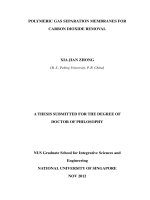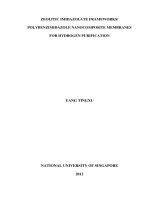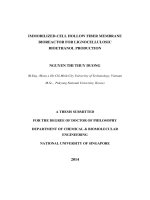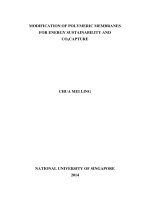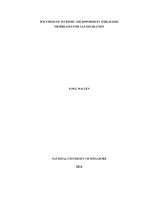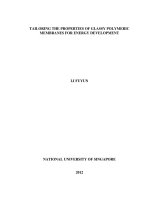Dual layer asymmetric hollow fiber membranes for gas separation
Bạn đang xem bản rút gọn của tài liệu. Xem và tải ngay bản đầy đủ của tài liệu tại đây (11.27 MB, 267 trang )
DUAL-LAYER ASYMMETRIC HOLLOW FIBER MEMBRANES
FOR GAS SEPARATION
LI DONGFEI
NATIONAL UNIVERSITY OF SINGAPORE
2004
DUAL-LAYER ASYMMETRIC HOLLOW FIBER MEMBRANES FOR
GAS SEPARATION
LI DONGFEI
(B. Eng., Dalian University of Technology)
A THESIS SUBMITTED
FOR THE DEGREE OF DOCTOR OF PHILOSOPHY
DEPARTMENT OF CHEMICAL & BIOMOLECULAR ENGINEERING
NATIONAL UNIVERSITY OF SINGAPORE
2004
i
ACKNOWLEDGEMENT
As a milestone, the thesis is by far the most significant achievement in my life. It is not
only the result of the five years of my research work but also the fruit concentrated the
painstaking efforts of many people who supported me and had faith in me in the past.
It could not even be dreamed without the elaborate guidance from Professor Chung
Tai-Shung Neal who was my main supervisor in National University of Singapore. I
have being greatly benefited from both his deep insight and devoted spirit in science.
The thoughts he has offered have enriched my thesis a lot. The things I have learned
from him are never just only the sense of research but the mission for ‘never give-up’
and many others. Apart from science, I owe him innumerable gratitude for pushing me
closer to the God. It makes me to live a peaceful life.
Gratitude also goes to my secondary supervisor Dr. Wang Rong from the Nanyang
Technological University for her supervision. Besides of being an excellent supervisor,
Dr. Wang Rong is also as close as a generous friend to me. I am glad that I have come
to get know her in my life.
I am greatly indebted to my former supervisor, Dr. Li Kang who moves to the Imperial
College now, for encouraging me to pursue academic career. His recognition is
definitely the root for the success I achieved today.
It is impossible to forget every single helping hand hid behind my success. I would like
to express my gratitude to Dr. Liu Ye and Dr. Ren Jizhong for their valuable
contribution, without that my thesis would never be so fruitful.
ii
I sincerely thank Professor D. R. Paul, the member of American Science Academy. He
provided me some useful references wrote by the earlier pioneers.
Needless to say, that I am grateful to all of my colleagues at IBM Singapore Pte Ltd,
Institute of Materials Research & Engineering, Institute of Environmental Science &
Engineering, and Department of Chemical & Biomolecular Engineering (NUS) for
their support. Especially I am indebted to Mr. S. C. Liang, Dr. Lin Huihui, Mr. Yao
Yizhao, Dr. Chen Sixue, Dr. Ma Kuixiang, Dr Cao Yiming, Dr. Cao Chun, Dr Tong
Yuejin, Dr. Liu Songlin, Mr. Liang Tee David, Mr. K. P. Ng, Ms Chng Meilin, Ms
Low Weiwei, and many others.
I would like to thank my wife Li Lintian and my daughter Jessie for their
understanding and love during the past few years. The support and encouragement
from my family were in the end what made my thesis possible.
Li Dongfei
March 23, 2004
Singapore
1.3.2.1 Pressure-driven membrane processes
iii
TABLE OF CONTENTS
ACKNOWLEDGEMENT
TABLE OF CONTENTS
SUMMARY
LIST OF TABLES
LIST OF FIGURES
LIST OF SYMBOLS
CHAPTER 1 INTRODUCTION
1.1 Definition of a separation membrane
1.2 History of separation membranes
1.3 Classification
1.3.1 Membrane classification
1.3.2 Membrane processes classification
1.3.2.2 Concentration-driven membrane processes
1.3.2.3 Thermally driven membrane processes
1.3.2.4 Electrically driven membrane processes
1.4 Membrane market
1.5 Applications of polymeric membranes in the field of gas separations
1.5.1 Air separation
1.5.2 Hydrogen recovery
1.5.3 Natural gas separation
1.5.4 Vapor / gas and vapor/vapor separation
i
iii
xi
xii
xiv
xxiv
1
1
2
7
7
8
8
9
9
9
10
11
13
14
15
17
iv
1.6 Objective and scope
1.7 Organization of the thesis
1.8 Significance of the thesis
CHAPTER 2 LITERATURE VIEW
2.1 Membrane materials
2.1.1 Experimental approach for membrane material selection
2.1.2 Performance prediction based on molecular structure
2.2 Formation of asymmetric polymeric membranes for gas separation
2.2.1 Asymmetric membranes
2.2.2 Phase inversion process
2.2.2.1 Thermally induced phase inversion (TIPS)
2.2.2.2 Dry process phase inversion
2.2.2.3 Wet process phase separation and macrovoid formation
2.2.2.4 The polymer-assisted phase-inversion (PAPI) process
2.2.3 Composite membranes
2.2.4 Membrane modification
2.3 Applications of coextrusion approach in the preparation of asymmetric
membranes
2.3.1 Coextrusion in dual-bath approach
2.3.2 Coextrusion in melt spinning process
2.3.3 Coextrusion in preparation of ceramic composite hollow fiber
membranes
2.3.4 Annular structure formation by coextrusion approach
2.3.5 Flat composite membranes by coextrusion / co-casting
17
19
22
24
24
26
27
31
32
32
33
38
40
45
45
48
50
52
58
59
60
60
v
2.3.6 Coextrusion in fabrication of dual-layer asymmetric hollow fiber
composite membranes
2.4 Hollow fiber membrane modules
2.4.1 Advantages
2.4.2 Literature survey on membrane modules
2.4.3 Aspects of hollow fiber module structures
2.4.4 Joule-Thomson effect
2.4.5 Packing fractions
2.4.6 Tubesheets
CHAPTER 3 DEVELOPMENT OF SINGLE-LAYER ASYMMETRIC
HOLLOW FIBER MEMBRANES FOR CO
2
/CH
4
SEPARATION
3.1 Introduction
3.2 Experimental section
3.2.1 Material preparation
3.2.2 Solubility parameters
3.2.3 Fabrication of asymmetric polyimide hollow fiber membranes
3.2.3.1 Measurement of spinning solution viscosity
3.2.3.2 Spinning procedures
3.2.4 Measurement of hollow fiber separation performance
3.2.5 Scanning electron microscopy (SEM)
3.2.6 Apparent skin layer thickness
3.3 Results and discussion
3.3.1 Preparation of membrane solution and its rheological characteristics
3.3.2 Effect of shear rate on the performance of hollow fiber membranes
62
68
68
68
69
70
72
73
75
75
77
77
77
78
78
78
79
80
80
81
81
84
vi
3.3.3 Effect of take-up speed on the performance of hollow fiber membranes
3.3.4 Conclusions
CHAPTER 4 SUPPRESSION OF CO
2
-INDUCED PLASTICIZATION IN
POLYIMIDE SINGLE-LAYER ASYMMETRIC HOLLOW FIBER
MEMBRANES
4.1 Introduction
4.2 Experimental section
4.2.1 Material preparation
4.2.2 Fabrication of asymmetric polyimide hollow fiber membranes
4.2.3 Measurement of hollow fiber separation performance
4.2.4 Scanning electron microscopy (SEM)
4.2.5 Thermogravimetric analysis (TGA)
4.2.6 Wide-angle X-ray diffraction (WAXD)
4.2.7
1
H-NMR spectroscopic analysis
4.2.8 Apparent dense selective-skin thickness
4.2.9 Heat treatment procedure
4.3 Results and discussion
4.3.1 The performance characteristics of 6FDA-2,6 DAT asymmetric hollow
fiber membranes
4.3.2 The effects of membrane solution rheology and spinning process on CO
2
induced plasticization
4.3.3 The effects of heat treatment on CO
2
induced plasticization
4.4 Conclusions
91
93
95
95
97
97
97
98
92
98
98
99
99
99
99
99
102
103
108
vii
CHAPTER 5 PREPARATION OF PI/PES DUAL-LAYER ASYMMETRIC
HOLLOW FIBER COMPOSITE MEMBRANES BY COEXTRUSION
APPROACH
5.1 Introduction
5.2 Experimental section
5.2.1 Material selection
5.2.2 Spinning solution preparation
5.2.3 Dual-layer spinneret design and spinning devices
5.2.4 Post-treatment
5.2.5 Evaluation of separation performance
5.3 Results and discussion
5.3.1 Formation of delamination-free dual-layer membranes
5.3.2 Fabrication of 6FDA–durene–mPDA/PES dual-layer membranes for gas
separation
5.3.3 Separation performance of 6FDA–durene–mPDA/PES dual-layer
membranes
5.3.4 Conclusions
CHAPTER 6 MORPHOLOGICAL ASPECTS AND STRUCTURE CONTROL
OF DUAL-LAYER ASYMMETRIC HOLLOW FIBER MEMBRANES
FORMED BY A SIMULTANEOUS CO-EXTRUSION APPROACH
6.1 Introduction
6.2 Experimental section
6.2.1 Membrane preparation
6.2.2 SEM specimen preparation
110
110
114
114
116
117
121
121
122
122
126
129
129
131
131
134
134
135
viii
6.2.3 Coating of SEM specimens and the optimal operation of SEM
6.3 Results and discussion
6.3.1 Integrity of dual-layer asymmetric hollow fiber membranes
6.3.2 The outer-layer morphology – the causes of macrovoid-free structure
6.3.3 Inner layer morphologies – the control of macrovoids growth
6.3.3.1 Influence of the inner membrane solution composition
6.3.3.2 Influence of the elongational draw ratio
6.3.3.3 Influence of the bore-fluid composition
6.3.3.4 Influence of the coagulation and spinneret temperatures
6.3.4 Interfacial morphology and delamination phenomena
6.3.4.1 Layers’ shrinkage vs. delamination
6.3.4.2 Membrane solutions’ chemistry vs. interfacial structure
6.3.4.3 Delamination vs. interfacial structure
6.4 Conclusions
CHAPTER 7 CHEMICAL CROSS-LINKING MODIFICATION OF
POLYIMIDE/PES DUAL-LAYER HOLLOW-FIBER MEMBRANES FOR
GAS SEPARATION
7.1 Introduction
7.2 Experimental section
7.2.1 Membrane materials
7.2.2 Fabrication of polyimide/PES dual-layer hollow fibers
7.2.3 Chemical cross-linking modification of dual-layer hollow fibers
7.2.4 Characterization
7.3 Results and discussion
138
140
140
141
144
145
150
152
153
154
154
157
159
160
161
161
162
162
163
164
164
165
ix
7.3.1 Fabrication of polyimide/PES dual-layer hollow fibers
7.3.2 FTIR characterization
7.3.3 Effects of cross-linking modification on gas separation properties
7.4 Conclusions
CHAPTER 8 FABRICATION OF LAB-SCALE HOLLOW FIBER
MEMBRANE MODULES WITH HIGH PACKING DENSITY
8.1 Introduction
8.2 Development of hollow fiber modules for gas separation
8.3 Limitations of small modules for performance prediction of industry-
scale membrane systems
8.3.1 The Joule-Thomson effect
8.3.2 The influences of fiber packing density, fiber properties, uniformity of
fiber distribution, and flow patterns
8.4 Objectives
8.5 Fabrication of lab-scale hollow fiber modules with high packing density
8.5.1 Module shell preparation
8.5.2 Module bundle preparation
8.5.3 Module assembly
8.5.4 Epoxy resin tube sheets casting
8.5.5 Post-treatment after casting
8.6 Method to increase the packing density of a lab-scale module
8.6.1 Definition of packing density
8.6.2 Ideal packing density
8.6.3 Boundary effect
165
165
170
175
177
177
178
185
185
186
188
189
190
192
193
194
196
197
197
197
198
x
8.6.4 Packing density of a real module
8.6.5 Improvement of packing density of lab-scale modules
8.6.5.1 A non-vacuum method to reduce module cross-sectional area
8.6.5.2 A vacuum method to reduce module cross-sectional area
8.7 Verification of the integrity of a lab-scale hollow fiber module
8.8 Conclusions
CHAPTER 9 CONCLUSIONS
REFERENCES
APPENDIX A
THICKNESS DEPENDENCE OF MACROVOID EVOLUTION IN WET
PHASE-INVERSION ASYMMETRIC MEMBRANES
A.1 Introduction
A.2 Experimental section
A.3 Results and discussion
A.3.1 Effect of membrane thickness on membrane morphology
A.3.2 Critical structure-transition thickness
A.4 Conclusion
199
200
200
203
204
205
207
209
230
230
231
232
232
233
236
xi
Summary
We have studied the fabrication of dual-layer asymmetric hollow fiber composite
membranes for gas separation. The dual-layer composite membranes were prepared by
simultaneously extruding a bore fluid and two polymer solutions from a specially
designed triple-orifice spinneret. This technique offers a platform to construct a novel
composite membrane consisted of a high-performance polymer with excellent
permselectivity and a common polymer with outstanding mechanical properties.
Starting from the spinneret design, the research work includes preparation of single-
layer asymmetric hollow fibers, optimization of dual-layer asymmetric hollow fiber
spinning, study of macrovoid formation, investigation of delamination phenomenon, as
well as fabrication of lab-scale hollow fiber modules. Extensive work was introduced
to explore the membrane formation induced by phase inversion. The concept of critical
membrane-structure transition thickness was raised to describe the transition from a
sponge-like to a macrovoid structure. The morphologies of the interfaces of dual-layer
hollow fibers were revealed. The uneven shrinkage effect was applied to explain the
delamination between inner and outer layers. Defect-free, delamination-free, dual-layer
hollow fiber asymmetric membranes were successfully demonstrated for gas
separation. The membrane plasticization caused by CO
2
was also studied and its
effects were significantly suppressed by surface modification using a novel chemical
cross-linking approach. Lab-scale hollow fiber modules with controllable packing
density were constructed and the detail procedure was developed.
xii
LIST OF TABLES
Table 1-1. Applications of gas separation membranes
Table 1-2. Main players in gas separation membranes
Table 2-1. Effect of side group on performance of polysulphone
Table 2-2. Summarization of membrane modification methods
Table 2-3. Summary of literatures on co-extruding/casting & dual-layer
composite membranes
Table 2-4. Joule-Thomson coefficients at 1 bar and 298K
Table 3-1. The solubility parameters of NMP, EtOH, H
2
O and their
difference to 6FDA-2,6 DAT
Table 3-2. The spinning conditions of batches 1 and 2
Table 3-3. The spinning parameters, performance of hollow fiber membranes
at different shear rates in the spinneret for batch 1
Table 3-4. The spinning parameters, performance of hollow fiber membranes
at different shear rates in the spinneret for batch 2
Table 3-5. The spinning parameters, performance of hollow fiber membranes
at different take-up speeds (batch 1, 6FDA-2,6 DAT/NMP
solution)
Table 4-1. The performance of hollow fiber membranes as a function of the
heat-treatment temperature
Table 5-1. O
2
permeability and O
2
/N
2
selectivity of 6FDA-durene, 6FDA-
mPDA, and 6FDA-durene/mPDA(50:50) (35 °C, 10 atm)
Table 5-2. Spinning conditions of dual-layer hollow fiber membranes
Table 5-3. Properties of 6FDA durene mPDA dense films
13
13
28
48
53
72
82
84
85
85
92
104
115
120
122
xiii
Table 5-4. Properties of 6FDA durene-mPDA/PES dual layer asymmetric
hollow fiber membranes
Table 6-1. The ID and compositions of the inner and outer layer membrane
solutions
Table 6-2. Spinning conditions of dual-layer asymmetric hollow fibers
Table 7-1. Gas permeance of the reference and cross-linked polyimide/PES
dual-layer hollow fiber modules (Pure gas tests)
Table 7-2. Gas permselectivity of the reference and cross-linked
polyimide/PES dual-layer hollow fiber modules (Pure gas tests)
Table 8-1. Characteristics of a Monsanto commercial module for H
2
recovery in US patent 4315819 & 4172885
Table 8-2. Parts, materials and tools involved in a modular module
fabrication
Table 8-3. Module specifications
Table 8-4. Comparison of module permeance & selectivity: pure gas vs
mixed gas
129
135
135
171
171
180
191
204
204
xiv
LIST OF FIGURES
Figure 1-1. Illustration of membrane separation process
Figure 1-2. Effect of surface porosity on the permeance of polysulfone
membrane before and after coating silicone rubber
Figure 1-3. Statistic results of publications on membranes for gas separation
in literatures
Figure 1-4. Annual sales of membranes and membrane modules for various
applications worldwide
Figure 1-5. Life-cycle curve of various membrane processes
Figure 1-6. Milestone in applications of membranes for gas separation
Figure 1-7. The recovery rate as a function of product concentration for
membranes with different selectivity in nitrogen enrichment from
the air
Figure 1-8. Effect of selectivity on energy consumption for 10 atm, 99% N
2
by membrane separation
Figure 1-9. The scope of the thesis
Figure 2-1. Conditions for a successful membrane-based gas separation
Figure 2-2. CO
2
/CH
4
permeability data points in various polymeric materials
Figure 2-3. Schematic molecular weight distribution curves for two
membrane materials with identical viscosity
Figure 2-4. Gibbs free energy of mixing for a binary solvent-polymer system
at temperature T
1
& T
2
(T
1
>T
2
)
Figure 2-5. Schematic temperature-composition phase diagram
for a binary polymer-solvent system
Figure 2-6. Illustration of thermally induced phase separation
1
5
7
10
11
12
14
15
18
24
26
29
34
36
xv
for a binary polymer-solvent system
Figure 2-7. Schematic diagram for dry process membrane formation
Figure 2-8. Schematic ternary phase diagram for wet process
Figure 2-9. Schematic diagram for growth of macrovoids
Figure 2-10. Classification of composite membranes
Figure 2-11. Some schematic drawings of coextrusion spinnerets
Figure 2-12. Statistic result on the subject of “membrane module” in literatures
by Chemical Abstract (SciFinder Scholar) in June 28th 2004
Figure 3-1. The influence of polymer concentration on membrane solution
viscosity at shear rate of 4 s
-1
at 25°C (6FDA-2,6 DAT/NMP
system).
Figure 3-2. The influence of temperature on the rheological characteristics
of 6FDA-2,2,6 DAT polymer solution (29% (w/w), solvent: NMP
Figure 3-3. The influence of temperature on the rheological characteristics
of 6FDA-2,6 DAT polymer solution (27% (w/w),
solvent: NMP/EtOH 85/15 (w/w)
Figure 3-4. (a). The influence of membrane solution shear rate on CO
2
and
CH
4
permeances of hollow fiber membranes spun from batch 1
(testing pressure, 100 psig). (b) The influence of membrane
solution shear rate on CO
2
/CH
4
selectivity of hollow fiber
membranes spun from batch 1 (testing pressure, 100 psig)
Figure 3-5. (a) The influence of membrane solution shear rate on CO
2
and
CH
4
permeances of hollow fiber membranes spun from batch 2
(testing pressure, 100 psig). (b) The influence of membrane
solution shear rate on CO
2
/CH
4
selectivity of hollow fiber
37
39
42
44
46
52
69
81
83
83
86
xvi
membranes spun from batch 2 (testing pressure, 100 psig)
Figure 3-6a. The influence of shear rate on the cross section and outer skin
morphologies of hollow fiber membranes spun from batch 1.
(A:812 s
-1
; B: 2436 s
-1
)
Figure 3-6b. The influence of shear rate on the inner skin morphologies of
hollow fiber membranes spun from batch 1. (A:812 s
-1
; B: 2436
s
-1
)
Figure 3-7. The influence of shear rate on the cross section and outer
morphologies of hollow fiber membranes spun from batch 2 (A,
806 s
-1
; B, 3225 s
-1
)
Figure 3-8. The influence of take-up speed on the performance of hollow
fiber membranes (membrane solution shear rate, 812 s
-1
;
membrane solution, 6FDA-2,6 DAT/NMP; testing pressure, 100
psig)
Figure 3-9. The influence of take-up speed on CO
2
and CH
4
permeances of
hollow fiber membranes (membrane solution shear rate, 1624 s
-1
;
membrane solution, 6FDA-2,6 DAT/NMP; testing pressure, 100
psig)
Figure 4-1. The influence of feed pressure on CO
2
and CH
4
permeances
(pure gas tests) batch 1, membrane solution shear rate of 812 s
-1
,
non-drawn, 7 days’ physical aging. batch 2, membrane solution
shear rate of 1612 s
-1
, non-drawn, 0 days’ physical aging
Figure 4-2. SEM pictures of 6FDA-2,6 DAT dense films and hollow fiber
membranes(A) dense film; (B) batch 1, 812 s
-1
, non-drawn; (C)
batch 2, 1612 s
-1
, non-drawn
86
88
89
89
92
93
100
101
xvii
Figure 4-3. X-ray diffraction patterns of 6FDA-2,6 DAT dense films and
hollow fiber membranes spun at a shear rate of 812 s
-1
, batch 1,
non-drawn
Figure 4-4. The effect of take-up speed on the relationship of CO
2
permeance
vs. pressure in pure gas tests for batch 1 (Membrane solution
shear rate of 812 s
-1
; take-up speed: 2.18 m/min; and 4.39 m/min)
Figure 4-5. The effect of take-up speed on the relationship of CO
2
permeance
vs. pressure in pure gas tests for batch 1 (Membrane solution
shear rate of 1624 s
-1
; take-up speed: 3.95 m/min; and 8.26
m/min)
Figure 4-6. The effect of heat treatment temperature on the CO
2
permeance
under pure gas tests, Batch 1, membrane solution shear rate: 812
s
-1
, non-drawn, Heat treatment after 7 days’ physical aging
Figure 4-7. The effect of heat treatment temperature on CO
2
/CH
4
selectivity;
batch 1, membrane solution shear rate of 812 s
-1
, non-drawn and
heat treatment after 7 days’ physical aging and testing pressure of
100 psig
Figure 4-8. The effect of heat treatment temperature on the apparent dense
skin thickness for hollow fiber membranes calculated based on
O
2
permeability (10.33 barrer), batch 1, membrane solution shear
rate of 812 s
-1
, non-drawn and heat treatment after 7 days’
physical aging
Figure 4-9. The effect of heat treatment temperature on the performance of
hollow fiber membrane , batch 1, membrane solution shear rate of
812 s
-1
, non-drawn and 60 days’ physical aging
102
103
103
104
104
105
105
xviii
Figure 4-10. SEM pictures of 6FDA-2,6 DAT hollow fiber membranes treated
at different temperatures: batch 1, membrane solution shear rate
of 812 s
-1
, non-drawn
Figure 4-11. X-ray diffraction patterns of 6FDA-2,6 DAT hollow fiber
membranes with different heat treatment temperatures
Figure 4-12.
1
H-NMR spectrum of untreated 6FDA-2,6 DAT hollow fiber
membranes, batch 1, membrane solution shear rate of 812 s
-1
,
non-drawn
Figure 4-13. Thermogravimetric analysis of hollow fibers after different heat
treatments, batch 1, membrane solution shear rate of 812 s
-1
, non-
drawn
Figure 5-1. Illustration of dual-layer asymmetric composite hollow fibers
Figure 5-2. Molecular structure of 6FDA-durene/mPDA co-polyimide
Figure 5-3. Effect of 6FDA-durene/6FDA-mPDA ratio on the permeability of
6FDA-durene/mPDA copolyimide
Figure 5-4. Critical concentration for 6FDA durene / mPDA
in a 5 / 3 NMP / THF mixture
Figure 5-5. Structure of dual-layer spinneret
Figure 5-6. Schematic diagram of a dual-layer asymmetric hollow fiber
spinning line
Figure 5-7. Delamination - effect of air gap
Figure 5-8. Delamination - effect of spinneret temperature
Figure 5-9. Delamination - effect of bore fluid
Figure 5-10. Delamination - effect of the concentration of inner-layer
membrane solution
106
107
107
108
111
114
115
117
118
119
123
124
125
125
xix
Figure 5-11. Delamination - effect of the post treatment process (x 100)
Figure 5-12. Cross sections of 6FDA durene-mPDA/PES dual-layer
asymmetric hollow fibers, A: near the edge of the outer skin, B:
interface, C: inner edge of the inner layer
Figure 5-13. Surfaces of 6FDA durene- mPDA / PES dual-layer asymmetric
hollow fiber, A: outer skin of the outer layer, B: outer skin of the
inner layer, C: inner lumen skin of the inner layer
Figure 5-14. The morphology of the outer interface skin surface of the PES
inner layer. The dual layer membranes were prepared using :
water as the bore fluid, B) NMP/Water (95/5) as the bore fluid.
Figure 6-1. Hollow fiber specimens on a stub SEM holder
Figure 6-2. Procedure of SEM specimen preparation for IL-OS & OL-IS
observation using liquid nitrogen
Figure 6-3. Influence of specimen coating time on IL-OS image quality
Figure 6-4. Influence of accelerating voltage and working distance (WD)
on image quality
Figure 6-5. Integrity of dual-layer asymmetric hollow fibers
Figure 6-6. The cross-sectional morphology of the outer Matrimid layer
laid on various inner layers
Figure 6-7. Determination of the critical structure transition thickness
for the outer-layer membrane solution
Figure 6-8. The thickest outer layer in this study (22 µm)
Figure 6-9. Visual estimation of the selective layer thickness in the Matrimid
outer layer
Figure 6-10. Influence of the addition of Matrimid in the inner membrane
126
127
127
128
136
137
139
140
141
142
144
144
145
xx
solutions
Figure 6-11. The cross-sectional structure of the inner layer spun from the
PES/PEO membrane solution
Figure 6-12. Phase diagrams of different membrane materials
Figure 6-13. Temperature dependence of the cloudy-point curve of the
PES/PEO/NMP/water inner-layer membrane solution
Figure 6-14. Isolated polymeric flake and fiber structure prepared from thermal
induced phase separation
Figure 6-15. Influence of the take-up speed and draw ratio on inner-layer
structure
Figure 6-16. The effects of bore fluid composition on membrane cross section
(upper) and inner skin (bottom) morphology
Figure 6-17. Influence of coagulation (top) and spinneret (bottom)
temperatures on membrane structure
Figure 6-18. Schematic diagram of the influence of shrinkage percentage on
dual-layer hollow fiber structure
Figure 6-19. Effect of the ratio of inner to outer membrane solution flow rates
on the shrinkage percentage and delamination
Figure 6-20. Effect of bore fluid composition on the shrinkage percentage and
delamination
Figure 6-21. Influence of membrane solutions’ solvent chemistry on the
interfacial structure (both inner and outer layers use the same
solvents)
Figure 6-22. Influence of membrane solutions’ solvent chemistry on the
interfacial structure (both inner and outer layer use different
146
147
148
149
150
151
152
153
155
156
156
157
xxi
solvents)
Figure 6-23. The influence of delamination on the outer-layer’s inner surface
morphology
Figure 7-1. SEM pictures of polyimide/PES dual-layer hollow fibers
Figure 7-2. FITR spectra of the outer polyimide layers a) unmodified, b-e)
cross-linked dual-layer hollow fibres (obtained by an immersion
in a 5% wt/v p-xylenediamine methanol solution for b) 5 min, c)
30 min, d) 60 min, and e) 16 h, respectively)
Figure 7-2a. Reaction between p-xylenediamine and imide group
Figure 7-3. FITR spectra of a) unmodified and b-d) cross-linked 6FDA-
durne/mPDA (50:50) dense films (obtained by an immersion in a
5% wt/v p-xylenediamine methanol solution for b) 5 min, c) 30
min, and d) 60 min, respectively).
Figure 7-4. Curve-fitting results of the FTIR spectrum of the cross-linked
polyimide outer layer (obtained by an immersion in a 5% wt/v p-
xylenediamine methanol solution for 5 min).
Figure 7-5. Effect of immersion time on the relative values of the calibrated
peak intensity at 1350 cm
-1
(a: the outer polyimide surface of a
dual-layer hollow fiber; b) the outer surface of a 40-µm thick
polyimide dense film.
Figure 7-6. FTIR spectra of the PES inner layers of a) unmodified and b)
cross-linked dual-layer hollow fibres (obtained by an immersion
in a 5% wt/v p-xylenediamine methanol solution for 16 h).
Figure 7-7. The effect of feed pressure on N
2
permeance of virgin and cross-
linked polyimide/PES dual-layer hollow fibers. Modules 1a, 2c,
158
159
165
166
166
167
168
169
170
xxii
3c, 4c, and 5c are the same samples as listed in Table 7-1.
Figure 7-8. The effect of feed pressure on CO
2
permeance of virgin and
cross-linked polyimide/PES dual-layer hollow fibres. Modules 1a,
2c, 3c, 4c, and 5c are the same samples as listed in Table 7-1
Figure 8-1. Shell-side fed hollow fiber module
Figure 8-2. Bore-side fed hollow fiber module
Figure 8-3. Shell-side fed hollow fiber module with a central distribution tube
Figure 8-4. Hollow fiber fabric bundle with a central distribution tube
Figure 8-5. Helical wound hollow fiber module with a central distribution
tube
Figure 8-6. Integrated two-stage hollow fiber module
Figure 8-7. Novel configuration of internally staged permeator
Figure 8-8. Application of submerged hollow fiber modules
Figure 8-9. The structure of lab-scale modular module
Figure 8-10. Bundle preparation & module assembly
Figure 8-11. Preparing for epoxy resin tube sheet casting
Figure 8-12. Ideal packing arrangement for cylindrical hollow fibers
Figure 8-13. Boundary effect
Figure 8-14. A sample of lab-scale modules
Figure 8-15. Non-vacuum method to reduce module cross-sectional area
Figure 8-16. Cross section of a bundle with high packing density
Figure 8-17. Module pressure resistance test
Figure A-1. Effect of membrane thickness on PES membrane structures
Figure A-2. Effect of membrane thickness on BTDA-MDI/TDI co-polyimide
membrane structures
172
173
179
180
181
182
183
183
184
184
190
193
195
198
199
200
202
203
205
233
234
xxiii
Figure A-3. Effect of membrane thickness on the thickness of spongelike
portion of PES membranes
Figure A-4. Effect of membrane thickness on the thickness of spongelike
portion of BTDA-TDI/MDI membranes
235
235


